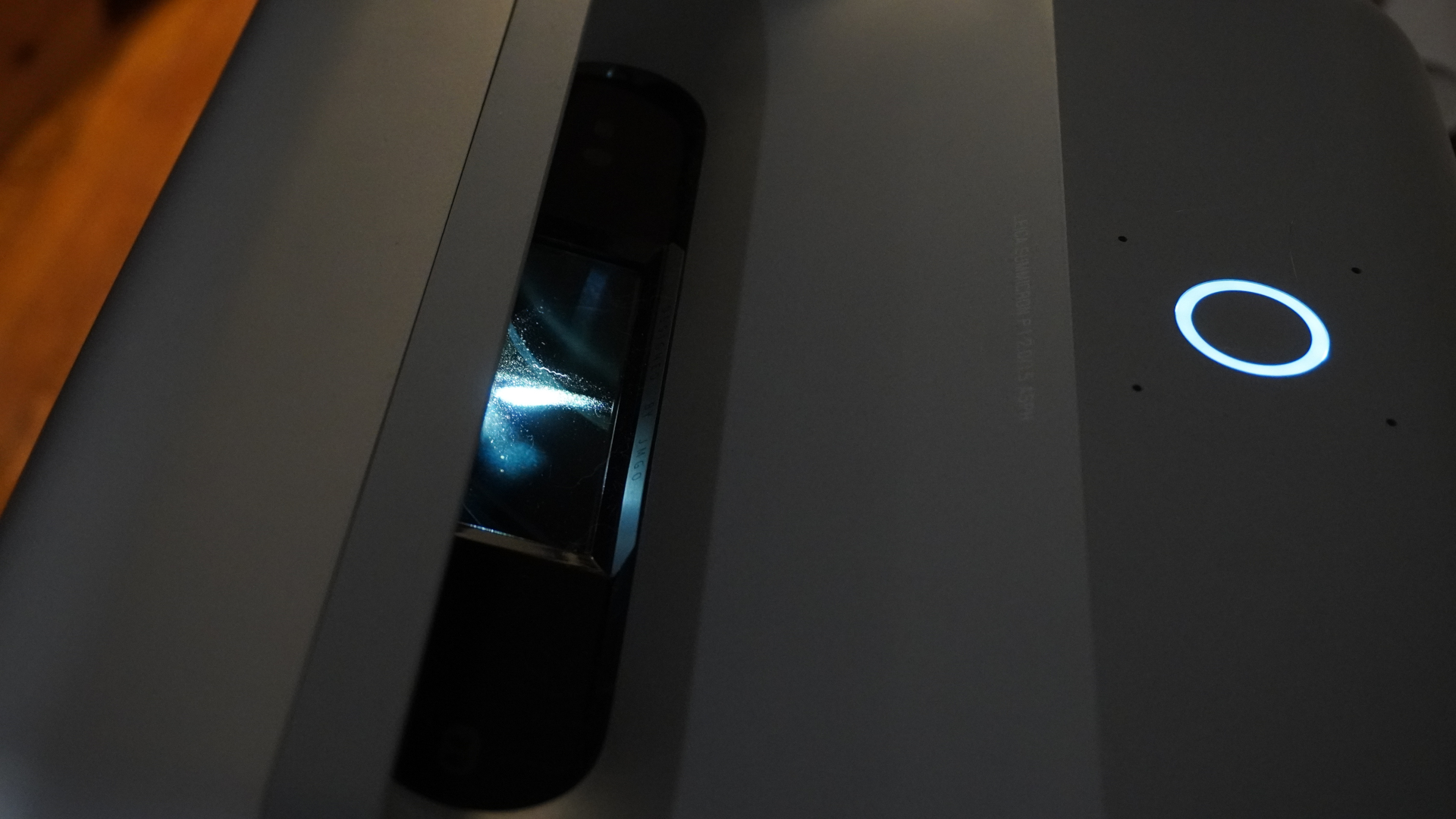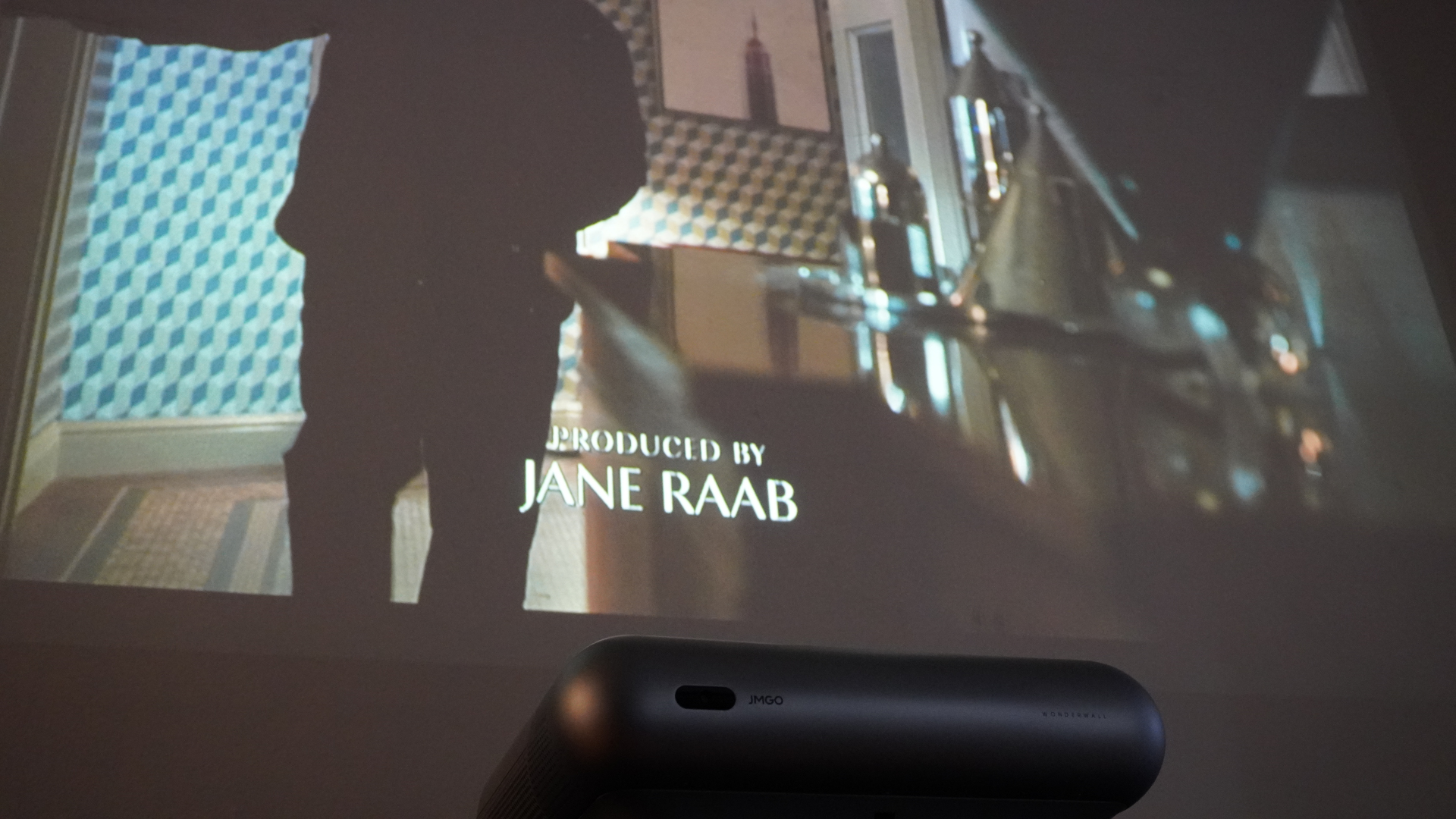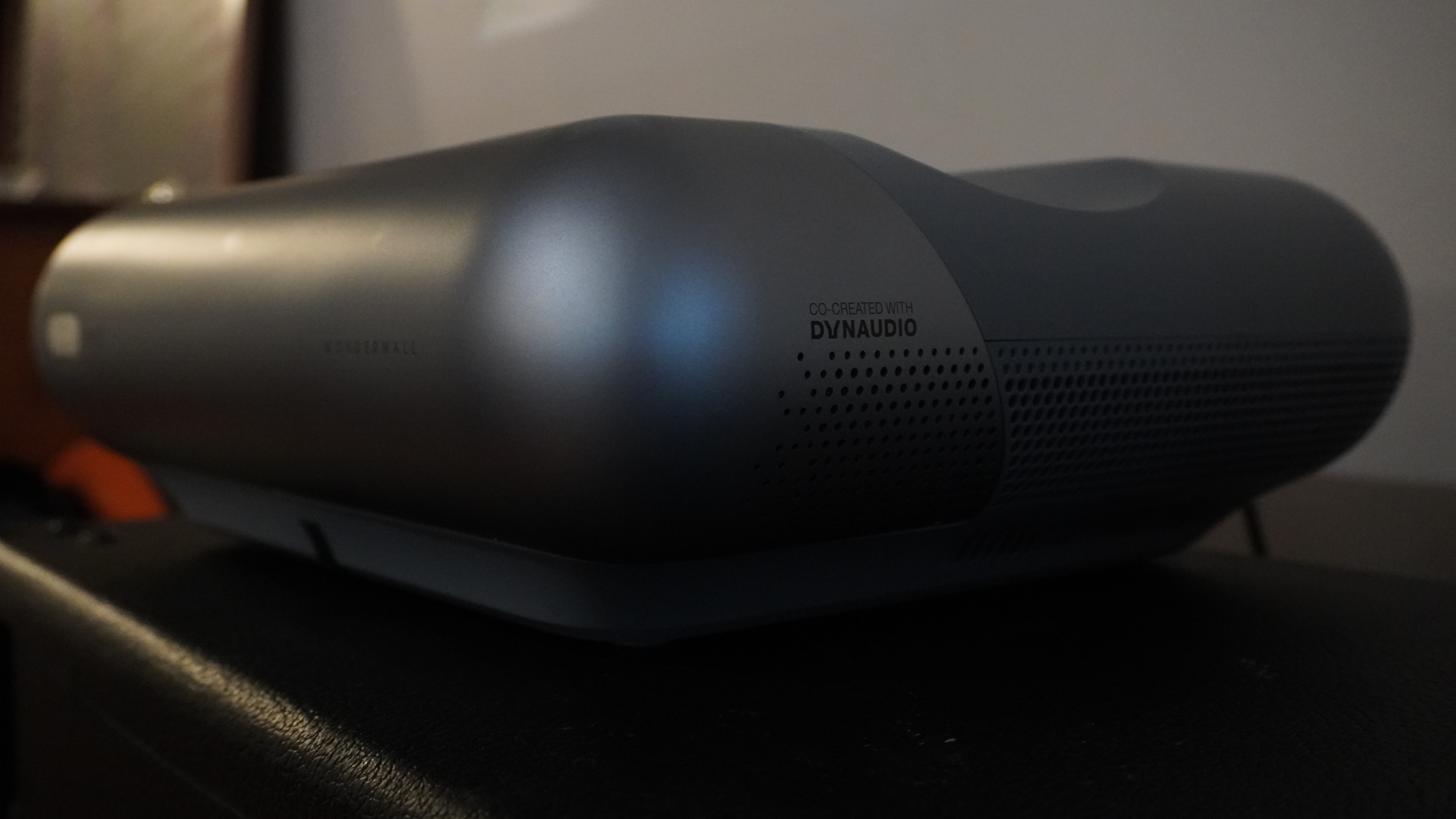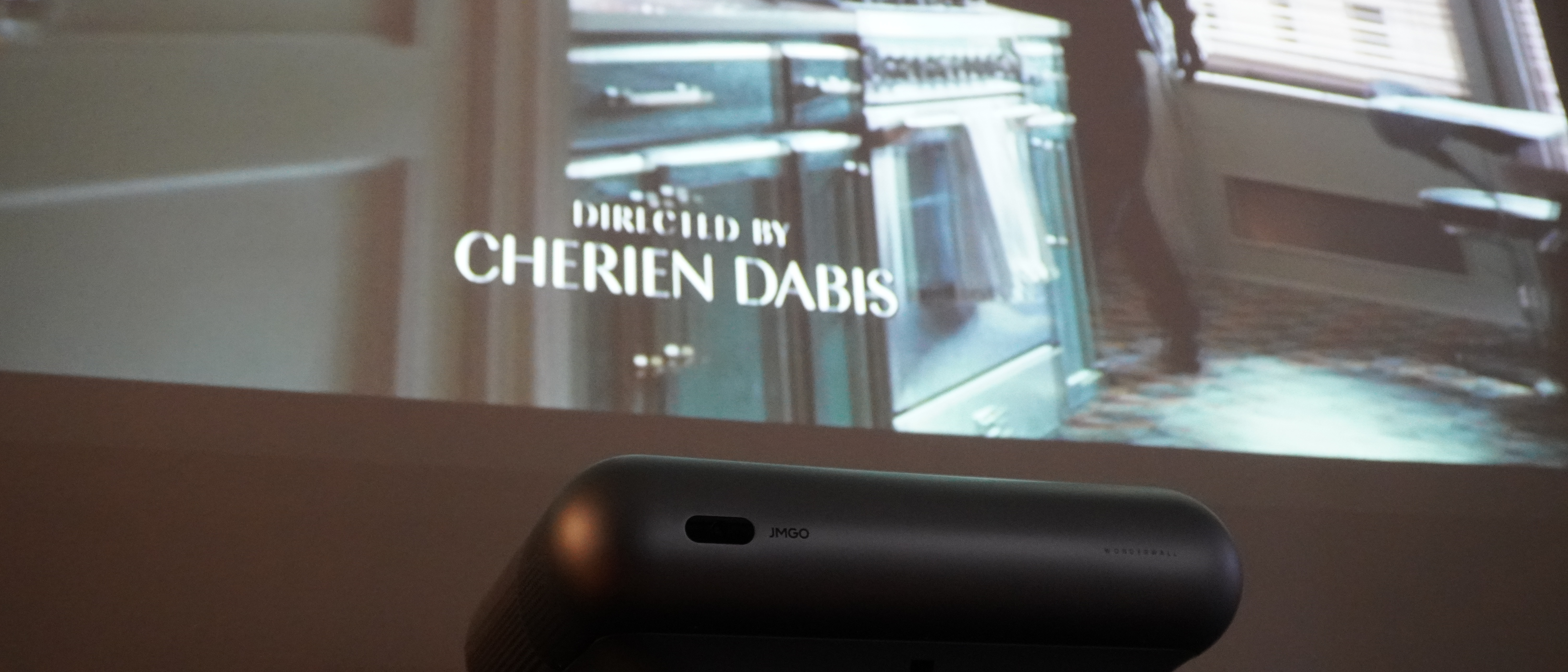TechRadar Verdict
The JMGO O1 Pro is a smaller and more affordable ultra-short-throw projector than you’ll usually find, but its image doesn’t live up to its more expensive competitors and even falls behind the longer-throw options that cost as much or less.
Pros
- +
Satisfying speakers
- +
Compact size
- +
Easy setup
Cons
- -
Drab image in daytime
- -
Not so “smart” OS
- -
Pricey for the picture
Why you can trust TechRadar
Two-minute review
The JMGO O1 Pro is a sneaky little ultra-short-throw projector. It’s about as small as they come while offering as big a picture as some of the best projectors. Perhaps more impressive is its price: at $1,599 (AU$2,299, around £1,225), the 01 Pro is about half the price of many of the other UST projectors on the market.
The lower price of the JMGO O1 Pro comes with some considerable trade-offs compared to its competition though. It’s only delivering a 1080p picture, and though its LED light source may be efficient and long-lasting, it’s not as bright and struggles to be as colorful as other laser-powered models.
The projector is an effective little home theater package in the right conditions. Doesn’t take a lot of space or setup to get a big, 100-inch picture up on the wall. And it’s bright enough in a dark room without necessarily needing to be pitch black, though it’d help. Daytime viewing is a poor experience, though. The projector pairs with a decent set of 10W speakers that may not have a lot of stereo separation but can fill a small-to-medium-sized room nicely.
Though the JMGO O1 Pro has a smart TV platform installed, it’s not terribly useful or reliable, and neither is the otherwise fancy-seeming remote control. Setting it up with an external streaming stick is a good idea, and that’ll leave just one extra HDMI port available for a game console or other input.
Despite the affordability of the JMGO O1 Pro as an ultra-throw-throw projector, it’s not terribly cheap in the grand scheme of things and not terribly high-performance for the price. The Xgimi Aura is more expensive, but a brighter, laser UST projector with a 4K picture and an actually useful smart OS. Then the 01 Pro is just crushed by longer-throw projectors. For about the same price as the JMGO O1 Pro, the Xgimi Horizon Pro 4K is brighter at 2,200 lumens and delivers a 4K picture. The $1399 Optoma UHD38 and $1599 Anker Nebula Cosmos Max 4K both delivery a bright 4K picture, and Anker’s recently-launched Nebula Cosmos Laser projector comes in a 1080p flavor for $1599 with a substantial uplift in brightness.
If you just want the cheapest UST projector, the JMGO O1 Pro may fit the bill, but the basic JMGO O1 is only $900 for a cut in brightness. That said, for anyone that can spend more or deal with the minor fuss of standard projector setup, there’s a lot better options available.

Design and features
- Projector, speakers, and smart OS in one package
- USB-C rechargeable remote
- Front-facing, gesture-control camera
- Exceptionally compact design
The JO1 is unlike its contemporary ultra-short-throw projectors from first appearance. This thing is small. While most UST projectors are content to take up a few square feet of space on an entertainment center, the JO1 is less than half the size of most of its competitors and looks like a little, silver blimp.
Inside of that small frame, the JO1 is packing its LED-powered projection system, a set of 10-watt speakers, a smart TV platform, and the sensor it needs for automatic focus, keystone, brightness, and color adjustments as well as a front-facing camera that can be used for gesture controls (or easily taped over for anyone who’s not digging a camera staring at them all the time in their living room).
That proprietary Luna OS smart TV platform leaves much to be desired. While it provides the means of changing settings and switching HDMI inputs, even offering a PiP of the HDMI input before needing to commit to it, its best left at that. Oftentimes buttons on the remote don’t do anything within an app, and the app store is somewhat suspect. After installing Netflix and launching the app, we reach a Get Started screen that doesn’t allow any sort of interaction. And if Xgimi hasn’t been able to get Netflix support on any of Android TV-powered projectors, we have even more doubts about JGMO’s ability to get proper support for apps.

JGMO built an exciting remote control for the projector with a chic metal design and USB-C charging, but it turns out to be a bit of a pain. It doesn’t like rapid inputs, as one might do to change the volume, and it almost never works from more than 10 feet away, which is where a user would ostensibly sit while using a projector with a 110-inch picture.
The projector is certainly better off using an external source. Though that makes the inclusion of just two HDMI ports a bit of a pain point. If they’re fill with a pair of streaming sticks, the two USB ports on the back will help power them up. The USB ports can also be used for playing local content. The ports are rounded out by both an optical and 3.5mm audio output. Those HDMI ports support CEC, which can be convenient, but we have it frequently boot up our PS5 unintentionally. Disabling CEC didn’t seem to create any problems, but a day later no sound was coming from any HDMI sources no matter how many settings we changed until we simply factory reset the device.
The projector’s speakers make up for its shortcomings somewhat, as they’re plenty loud for a 100 to 200-sq.-ft room without distorting too much as the volume pushes higher. Bass isn’t a standout aspect of the speakers, though, so the oomph factor could benefit from an external audio device.

Picture quality
- Big picture with little fuss
- Automatic setting adjustments
- Lacking brightness for daytime use
The promise of an UST projector is a big picture that’s easy to get — no messing around with where in the room you need to put the projector to get the image up on the wall in the right size. It’s easy to square away and a few inches backward or forward can easily stretch the picture to fit.
The JMGO O1 Pro certainly fits that bill. It’s a cinch to get an 80-inch picture or a 110-inch picture, whatever you want. The projector can automatically keystone the image if it’s not quite squared away. It’ll automatically focus as well, and the image can digitally shrink down if you want a smaller picture and can’t just move the projector closer to the wall.
For its sticker price you’d expect an exceptional image, but alas, the JMGO O1 Pro isn’t consistently delivering it. The projector boasts a 1,500 ANSI Lumen peak brightness (or 1,250; the company isn’t consistent with its marketing). That might sound bright, but it can hardly hold up during the daytime. In our living room, it takes all the shades drawn, all the lights out, and overcast weather to get a tolerable picture during the day. It’s good enough for cartoons and bright content in those conditions, but anything that gets darker is just about impossible to watch.
As easy as it is to get a large picture from the JMGO O1 Pro, it’s a lot more work to get a good picture. Settings are all over the place. To get a useful image, we have to change the Brightness to “High Brightness” in Projection Settings, then pop over into Video Settings and set Image Mode to “Bright Colored,” and from there turning HDR off makes for a brighter picture but sucks all the life out of the color while HDR provides a more compelling images but costs a bit of brightness and sinks shadows into dark depths it's hard to make anything out in.
It’s easy to accidentally end up with a horrible picture. A few wrong toggles and it’s a bland image that leaves half of everything washed out and the rest too dark, not to mention the motion smoothing is awful if left on. So at worst it’s bad, and at best it’s OK. Mind you, this is $1,599 for a 1080p/60 picture.
To really enjoy the picture, you’re going to need fine control of the setup, ideally a room that can go completely dark. That’s asking a lot for a projector that’s built around simplicity. Meanwhile a half dozen other projectors that cost less go brighter, just as big, and double down on picture quality with upgrades like 4K resolution or increased refresh rate. Very few will be ultra-short-throw, but they’ll probably be worth that single trade-off for those who can work around a longer throw.
Should you buy the JMGO O1 Pro?

Buy it if...
You want the smallest UST projector
UST projectors make a pretty compact home theater setup, but the JMGO O1 Pro is outright tiny compared to its competitors. It’ll take up little more space than the box a pair of boots would come in.
You want a big picture in a small room
All you need is a few inches of space between your wall and the JMGO O1 Pro to get a massive picture. It’s easy to get a huge, square picture for a comfy little home theater.
You forget to turn off your electronics
The JMGO O1 Pro’s LED light source is low energy and long-lasting, boasting a 45,000-hour lifespan. So if you accidentally leave it on from time to time, it’s not going to dramatically shorten the lifespan of your projector.
Don't buy it if...
You want the best picture for your money
At $1,599, the JMGO O1 Pro is hardly a budget home theater device. It’s unique, but its 1080p picture isn’t bright enough or colorful enough to compete with some of the other options in and below its price.
You don’t need an UST projector
UST projectors are convenient for how easy it is to get a big picture, but if you’ve got some space to set up a longer-throw projector at a distance, you can get a sharper, brighter, more colorful picture and plenty of other benefits without having to pay more.
You don’t have a room that can get really dark on demand
The JMGO O1 Pro is a decent in a dark room but barely passable with ambient light going on. Unless you’ve got major control of the ambient light in the room, you’ll frequently run into situations where the projector is just hard to enjoy.
Over the last several years, Mark has been tasked as a writer, an editor, and a manager, interacting with published content from all angles. He is intimately familiar with the editorial process from the inception of an article idea, through the iterative process, past publishing, and down the road into performance analysis.

